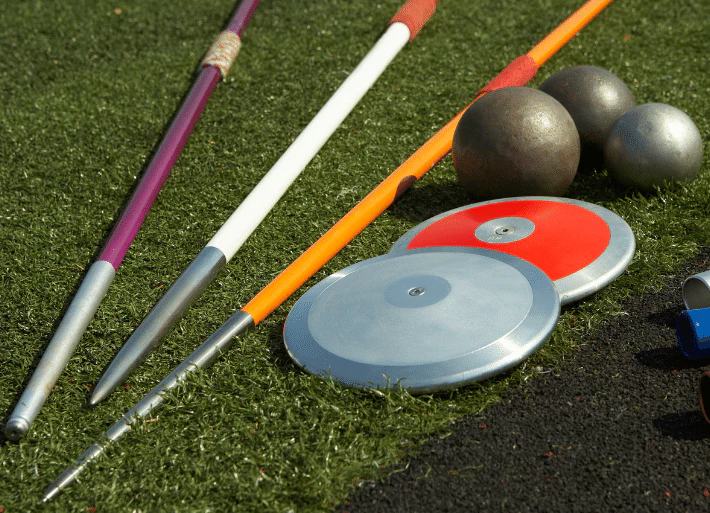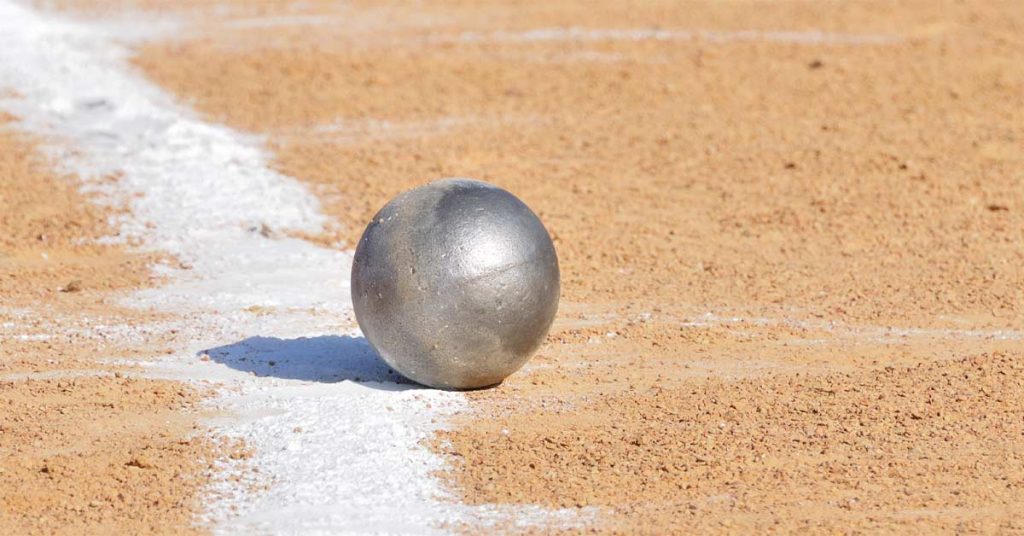A standard shot put used in track and field competitions typically weighs 16 pounds (7.26 kilograms) for men and 8.8 pounds (4 kilograms) for women. The weight of the shot put can vary slightly depending on the specific rules and regulations of the competition or organization, but these are the standard weights for most competitions.
How is shot put defined in athletics?
Shot put, a classic event in athletics is a sport that showcases an athlete’s raw power and precision.
Define shot put as a track and field event:
Shot put is a field event in track and field athletics where athletes compete to throw a heavy spherical object, known as the “shot,” for maximum distance. The shot is typically made of metal (usually brass or iron) and has a diameter that ranges from 95mm to 110mm for men and 95mm to 104mm for women.
Athletes, known as shot putters, attempt to launch the shot from a seven-foot (2.135 meters) diameter circle into a designated landing area.
Furthermore, the key characteristic of shot put is that it requires a combination of strength, technique, and explosiveness. Athletes must use their entire body to propel the shot as far as possible while staying within the circle.
The objective of shot put:

The primary objective of shot put is to throw the shot as far as possible within the rules and regulations of the sport. Athletes aim to achieve the maximum distance with their throws, and the athlete who accomplishes the longest throw among all participants is declared the winner.
Moreover, to achieve this objective, shot putters need to generate maximum force and velocity during the throw while maintaining proper technique. It’s a sport that demands a unique blend of power, speed, balance, and precision.
Its historical significance:
Shot put has a rich historical background and can be traced back to ancient Greece, where it was part of the ancient Olympic Games. Back then, the shot was made of stone, and the event had both practical and symbolic significance.
In ancient times, the shot put was seen as a test of a warrior’s strength and skill in throwing heavy objects, which could have practical applications in battle. It was also symbolic of the Greek god Zeus, who was often depicted holding a large stone or thunderbolt.
Over time, shot put evolved into a competitive sport with standardized rules and weights. Today, it remains a fundamental and popular event in track and field, embodying the essence of physical prowess and athletic excellence.
Shot put also holds historical significance in the context of gender equality in sports. The introduction of different shot put weights for men and women reflects the evolving recognition of women’s athletic abilities and the effort to create equitable opportunities for both genders in sports.
What is the standard shot put weight for men?
The standard shot put weight for men is 16 pounds, which is equivalent to approximately 7.26 kilograms. This weight has been established as the norm for men’s shot put in international track and field competitions, including the Olympic Games. The 16-pound shot put is a challenging weight that requires significant strength and technique to manipulate effectively.
Furthermore, the selection of this weight is based on a balance between tradition and the practicality of achieving maximum distances while ensuring athlete safety. It represents a significant challenge for male shot putters, pushing them to develop their power and throwing technique to excel in the sport.
What is the standard shot put weight for women?
For women, the standard shot put weight is 8.8 pounds, which is equivalent to approximately 4 kilograms. This weight is lighter than the men’s shot put to account for physiological differences in strength and muscle mass between genders.
Moreover, the 8.8-pound shot allows female athletes to compete at a high level while minimizing the risk of injury associated with heavier weights.
Like the men’s shot, the 8.8-pound shot put is used in international competitions, including the Olympics, and it serves as the standard for women’s shot put events worldwide. It strikes a balance between promoting fairness and creating a safe competitive environment.
How do shot put weights vary in different competitions?
While the standard shot put weights mentioned above are widely accepted and used in most international competitions, some variations may exist depending on specific competition rules or organizations. These variations can include:
Youth and junior categories: In competitions for younger athletes, such as youth and junior divisions, shot put weights are often reduced to accommodate the physical development of these athletes. The weights can vary depending on age groups and regional regulations.
Masters or senior categories: In masters track and field competitions, which cater to older athletes, shot put weights may also vary. Lighter shot puts are sometimes used to reduce the strain on aging bodies while still allowing for competitive participation.
Local or club-level events: In less formal or local track and field events, there may be more flexibility in shot put weights. Organizers might allow athletes to use different weights based on their preferences or availability of equipment.
Why do men and women use different shot put weights?
The difference in shot put weights for men and women is rooted in physiological disparities between the two genders. These differences can be summarized as follows:
Muscle Mass: Men generally have a higher percentage of lean muscle mass compared to women. This increased muscle mass contributes to greater strength, particularly in upper body and core muscles, which are crucial for shot put.
Bone Density: Men typically have denser bones than women, providing additional support and stability when handling heavier objects.
Hormonal Factors: Hormonal variations, including higher levels of testosterone in men, can lead to increased muscle development and strength.
To ensure fairness in shot put competitions, different shot put weights are used for men and women. The heavier 16-pound shot for men and the lighter 8.8-pound shot for women aim to level the playing field by accounting for these physiological differences.
How do shot put weights impact performance and technique?
Shot put weights have a profound impact on an athlete’s performance and technique:
- Power Requirement: Heavier shot puts demand more raw power to propel them over longer distances. This necessitates greater strength and explosiveness from athletes.
- Technique Adaptation: Athletes must adjust their throwing techniques based on the shot put weight. Moreover, A heavier shot requires more controlled and precise movements to maintain balance and release the shot effectively.
- Injury Risk: Using an inappropriate shot put weight can increase the risk of injury. Athletes who attempt to throw a shot that is too heavy for their level of strength and technique may strain muscles or sustain other injuries.
- Consistency: Standardized shot put weights ensure consistency and fairness in competition. In addition, athletes can train and compete with a clear understanding of the equipment they’ll be using.
What were the historical variations in shot put weights?

Shot put weights have evolved significantly over time. In ancient Greece, stone shots of varying sizes were used, and there was no standardized weight. These early variations were chosen more for practicality and symbolism than for competitive fairness.
As the sport modernized, particularly in the 19th and early 20th centuries, shot put weights began to standardize. The early 20th century saw men’s shot put weights range from 12 to 16 pounds in various competitions.
But eventually, the 16-pound shot became the international standard. Similarly, women’s shot put weights have seen variations before settling on the current standard of 8.8 pounds.
How has standardization impacted the sport?
The standardization of shot put weights has had several significant impacts on the sport:
- Fairness: Standardized weights ensure fairness by providing a level playing field for all competitors. Athletes know what to expect and can train accordingly.
- Records and Comparisons: Standardized weights enable the establishment of consistent records and allow for meaningful comparisons of performances across different competitions and eras.
- Safety: Standardization helps prevent athletes from attempting to throw excessively heavy or light shots, reducing the risk of injuries.
- International Competition: Standard weights are essential for international competitions like the Olympics, where uniformity is crucial for fairness and consistency in the sport.
FAQ’s
How heavy is a men’s high school shot put?
A men’s high school shot put typically weighs 12 pounds (5.44 kilograms).
Do all shot puts weigh the same?
No, shot puts come in various weights, with different categories for men and women. Men’s shot puts typically range from 12 to 16 pounds (5.44 to 7.26 kilograms), while women’s shot puts typically weigh around 8.8 to 9.9 pounds (4 to 4.5 kilograms).
What is the weight of javelin in men?
The weight of a men’s javelin in track and field competitions is typically 800 grams (1.76 pounds).
What is the world record in men’s shot put?
As of my last knowledge update in September 2021, the men’s shot put world record was 23.12 meters (75 feet 10.25 inches) set by Randy Barnes of the United States in 1990. Please note that records may have changed since then.
How heavy is a women’s javelin?
A women’s javelin in track and field competitions typically weighs 600 grams (1.32 pounds).
How heavy is women’s weight throw?
The weight used in women’s weight throw, also known as the hammer throw, typically weighs 4 kilograms (8.8 pounds) in international competition. However, there are different weight categories for women’s weight throw in various competitions.
Final Words
In conclusion, the weight of a shot put is a crucial aspect of the sport of track and field, with specific standard weights established for men and women. The differentiation in shot put weights reflects the physiological differences between genders, promoting fairness and safety in competitions.
Shot put weights have a profound impact on an athlete’s performance and technique, necessitating a delicate balance between power and precision.
Moreover, these standardized weights ensure consistency in records and provide a level playing field for athletes across the world. The historical changes in shot put weights, from ancient variations to modern standardization, illustrate the sport’s evolution and adaptation to meet contemporary needs while preserving its rich historical significance.
Overall, understanding the purpose behind different shot put weights and the historical context surrounding them enhances our appreciation of this dynamic and enduring track and field discipline.









